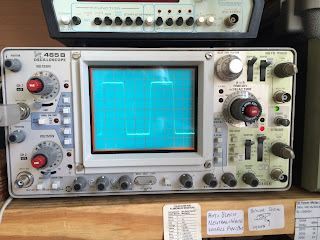As a learning exercise I measured the characteristics of a Triple Tuned Circuit Bandpass Filter in my junkbox. This is a board that came from the now retired kit from the company Kits and Parts.com. This kit is called the multiPig+. Details of this kit can be found in the retired kits section of the aforementioned website. The measurement details are in my notes below. The 40M filter seems to be within spec and was relatively easy to align. Minimum IL = -5.8dB. However the 20M filter was difficult to align as can be seen from the Sweeperino measurements. Try as I might I could not eliminate the 'second hump'. I assume this is one reason why the IL = -9dB.
The experiment also illustrates the utility of the Sweeperino to understand exactly what the filter shape characteristics are in a fast efficient way.
Next I will try to calculate the theoretical IL and BW for a triple tuned circuit and compare the results.









